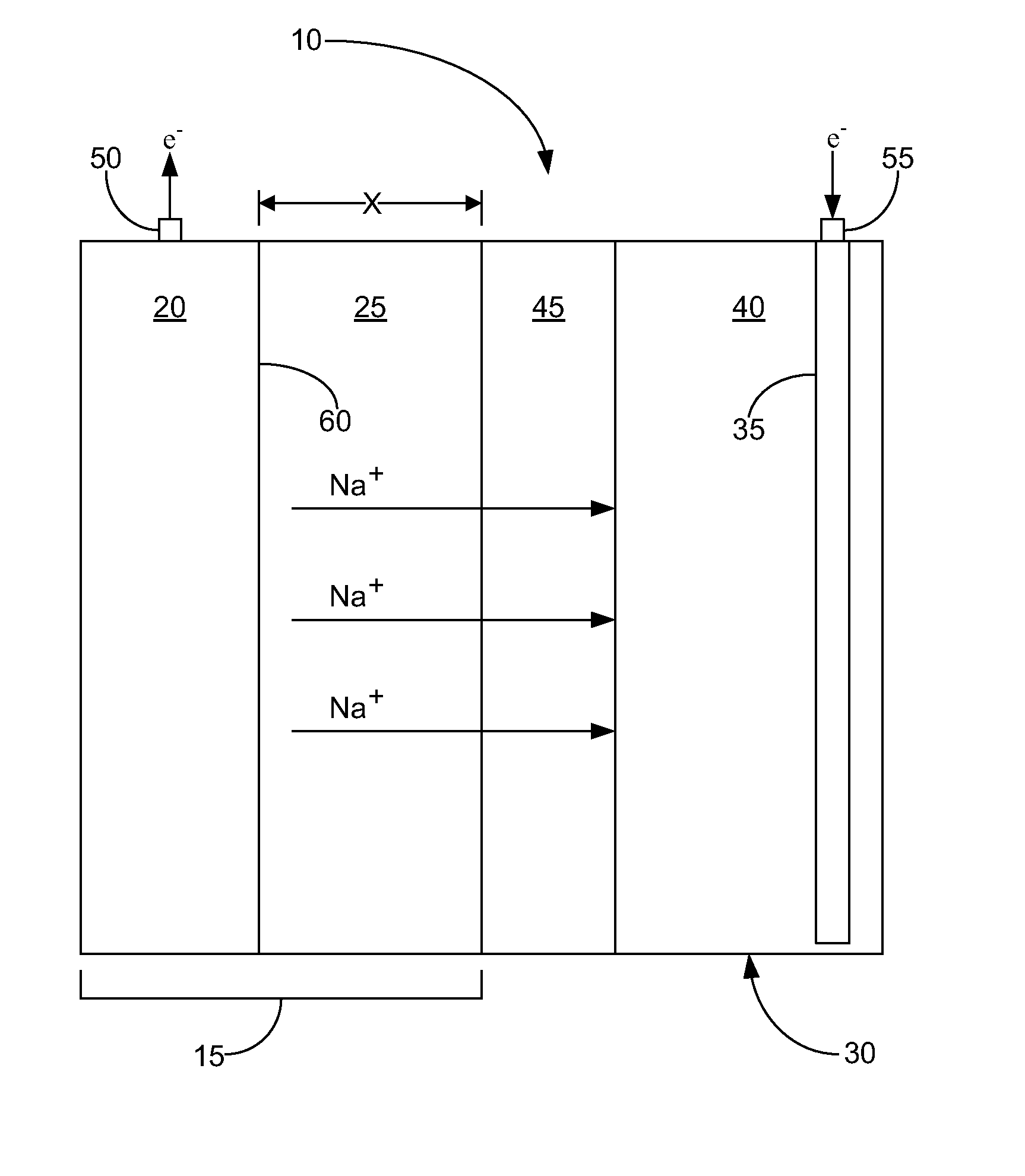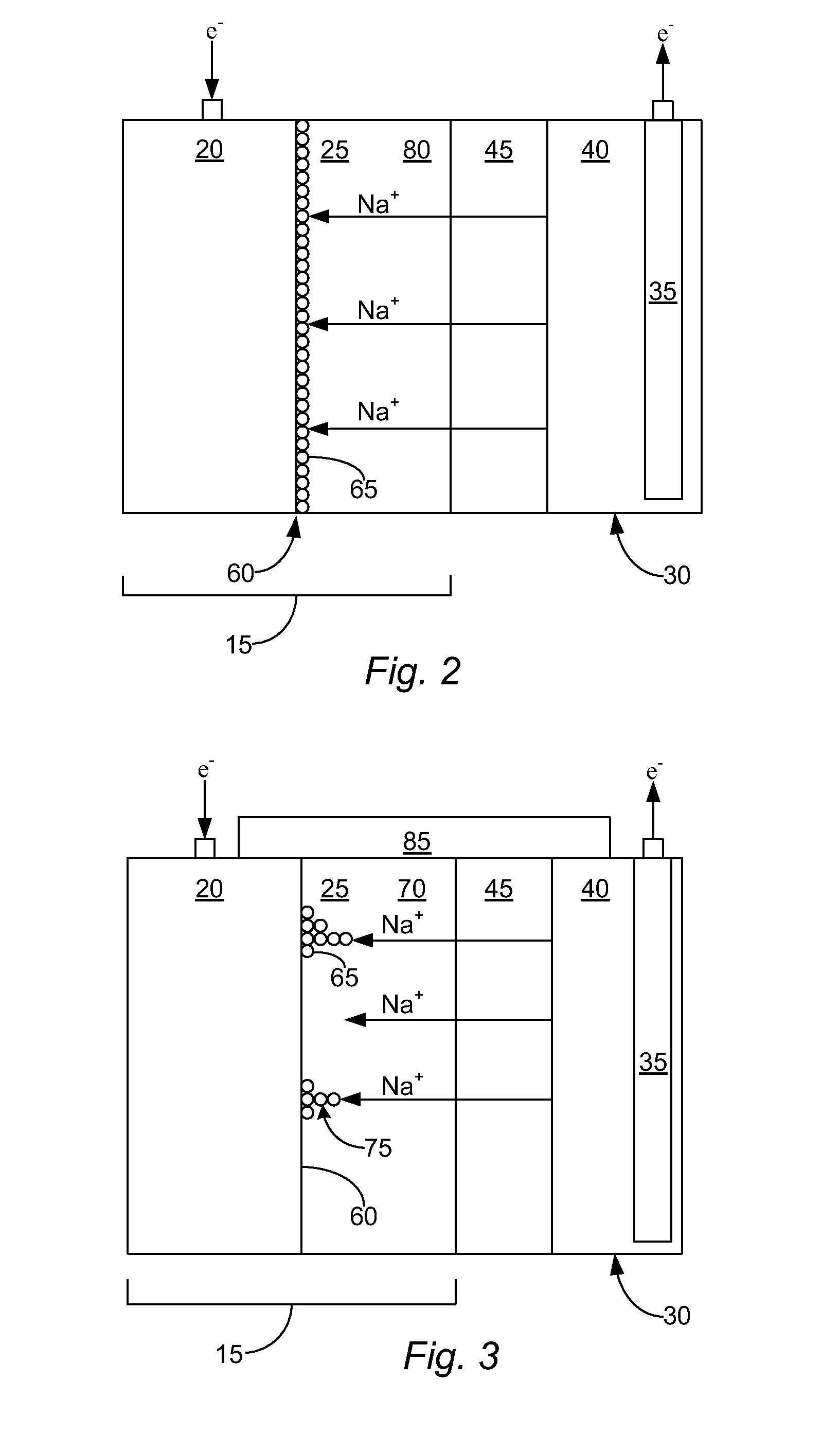Solid-state sodium-based secondary cell having a sodium ion conductive ceramic separator
a sodium ion conductive ceramic separator and sodium-based secondary cell technology, applied in secondary cell details, nickel accumulators, sustainable manufacturing/processing, etc., can solve the problems of significant thermal management problems, drop in faradaic efficiency and battery capacity loss, and achieve the effect of being below the melting point of sodium metal
- Summary
- Abstract
- Description
- Claims
- Application Information
AI Technical Summary
Problems solved by technology
Method used
Image
Examples
example 1
[0068]In this example, an embodiment of the solid-state sodium-based secondary cell 10 was fabricated and tested. In this regard, the system included a solid sodium negative electrode 20, a NaSICON electrolyte membrane 45, and an organic negative electrolyte 25. This system further included a sodium ion solution between the sodium metal negative electrode and the NaSICON membrane, thereby removing the Na++1e−<→Na° reaction from the NaSICON surfaces and preventing direct contact between the electric conducting sodium and the electrolyte membrane.
[0069]A NaSICON tube with a closed end was rough surface ground on a 40 micron grit polishing wheel. The tube dimensions were approximately: 14.7 mm O. D. with a wall thickness of 1.4 mm. A 2.5 cm diameter NaSICON disk, about 1 mm thick, was surface polished to a 0.33 micron surface finish. Both NaSICON parts were dried in-vacuo overnight at about 450° C. and then brought into an argon-filled glove box. The organic electrolyte solution was 1M...
example 2
[0072]In a second example, FIGS. 6 and 7 show some non-limiting experimental results that indicate the electrical potential measured over an extended period of time from two embodiments of the solid-state sodium-based secondary cell. In this regard, the cells used to obtain the results in both figures comprised a solid sodium metal negative electrode in contact with an ionic liquid. With respect to the ionic liquids used in the cells, the cell used to obtain the results shown in FIG. 6 comprised N-methoxyethyl-N-methyl-pyrrolidinium and sodium bis(trifluoromethane-sulfonyl)imide, and the cell used to obtain the results shown in FIG. 7 comprised propylmethyl-pyrrolidinium and bis(trifluoromethane-sulfonyl)imide. Additionally, the ionic-liquid-containing negative electrolyte in both cells was in contact with a NaSICON membrane. Finally, in both cells, the positive electrode comprised a nickel mesh electrode disposed in a positive electrolyte comprising a about 50% sodium hydroxide sol...
PUM
| Property | Measurement | Unit |
|---|---|---|
| operating temperature | aaaaa | aaaaa |
| operating temperature | aaaaa | aaaaa |
| operating temperature | aaaaa | aaaaa |
Abstract
Description
Claims
Application Information
 Login to View More
Login to View More - R&D
- Intellectual Property
- Life Sciences
- Materials
- Tech Scout
- Unparalleled Data Quality
- Higher Quality Content
- 60% Fewer Hallucinations
Browse by: Latest US Patents, China's latest patents, Technical Efficacy Thesaurus, Application Domain, Technology Topic, Popular Technical Reports.
© 2025 PatSnap. All rights reserved.Legal|Privacy policy|Modern Slavery Act Transparency Statement|Sitemap|About US| Contact US: help@patsnap.com



